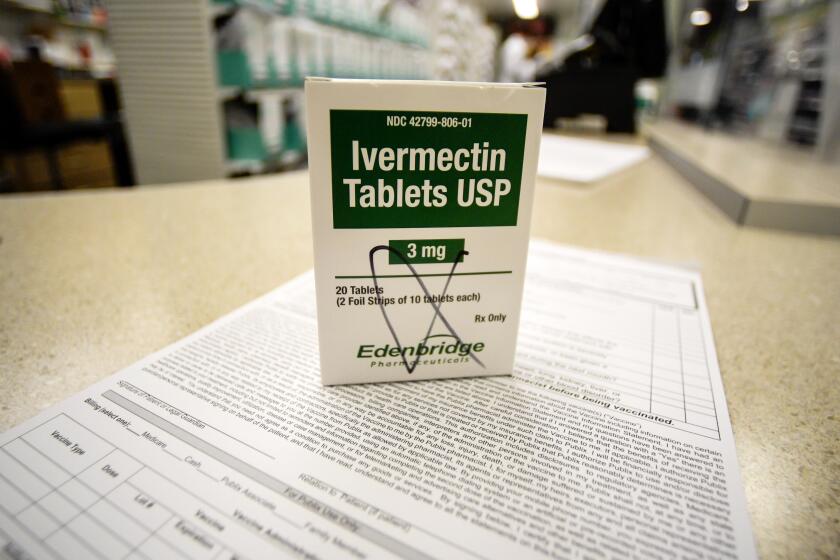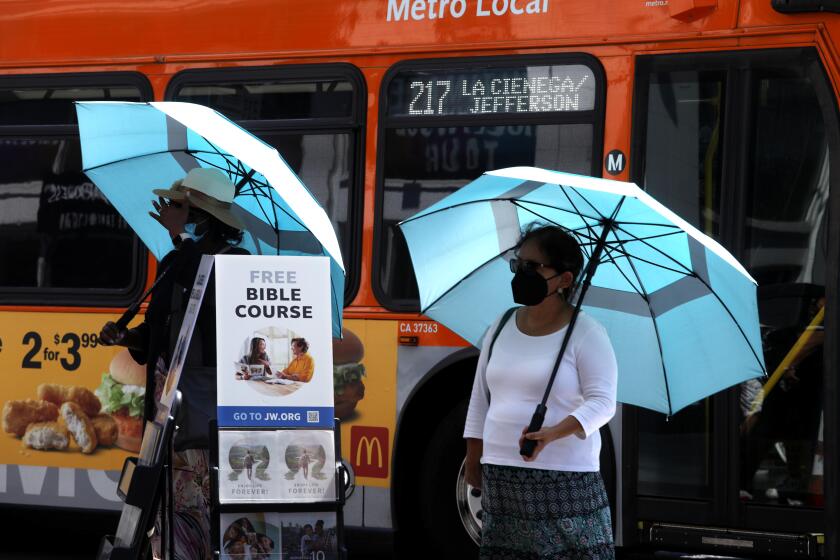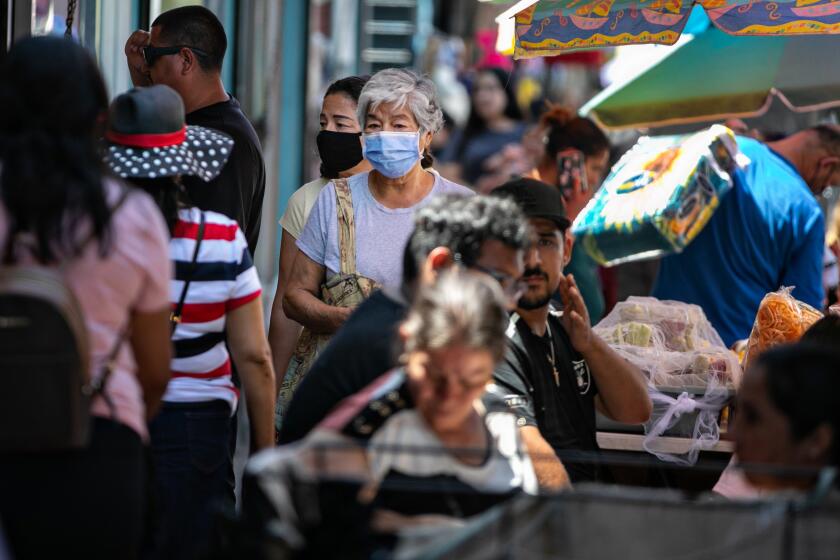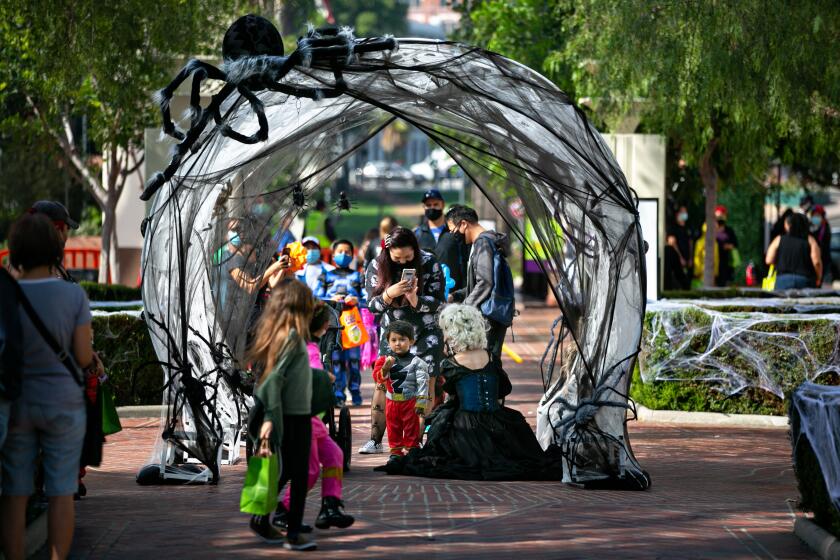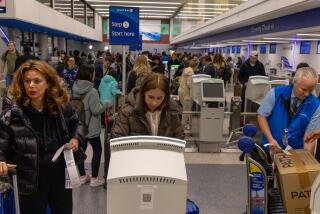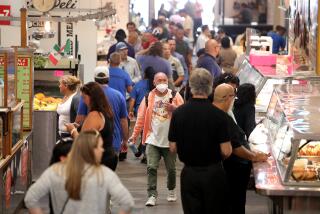Coronavirus subvariant BA.2.75.2 appears in L.A. County. How worried should we be?
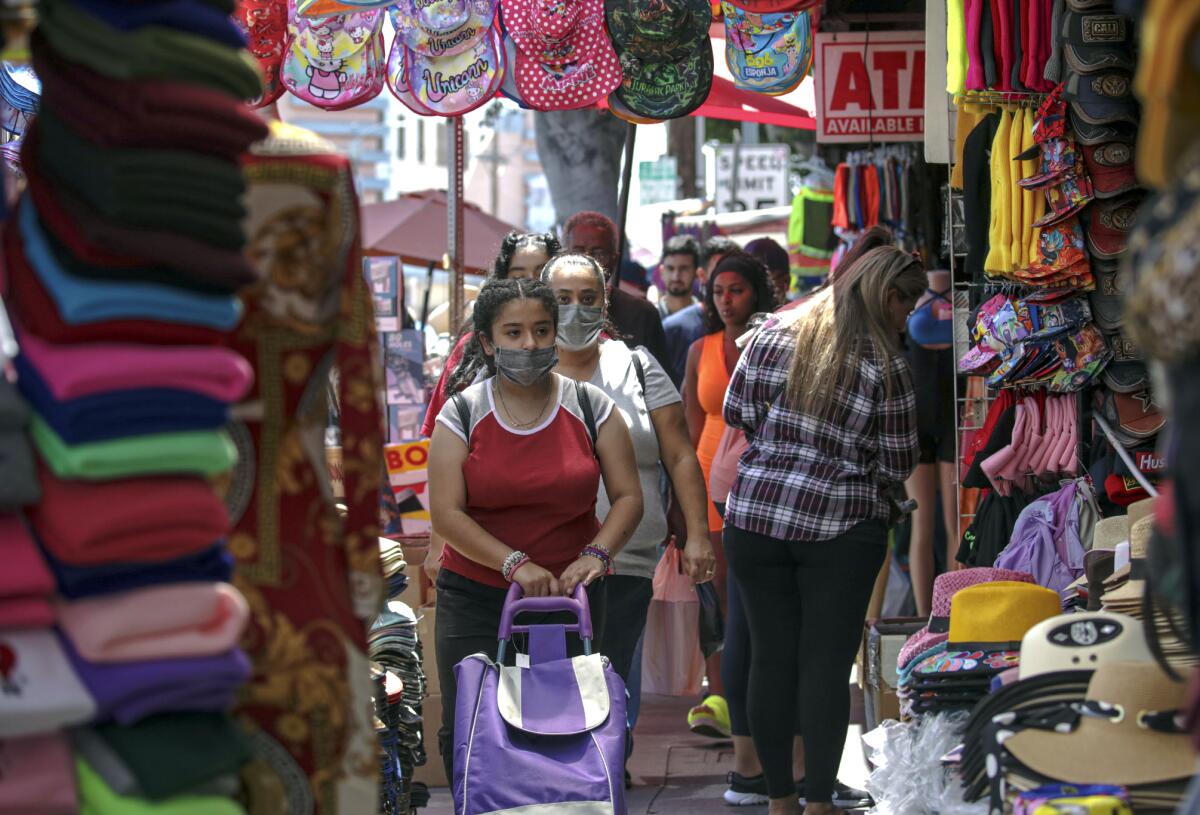
The Omicron subvariant BA.2.75.2 — a newer coronavirus strain some scientists fear could be problematic — has arrived in Los Angeles County.
BA.2.75.2 has been described by Dr. Anthony Fauci, President Biden’s chief medical advisor for the pandemic, as “one that looks suspicious — that it might start to evolve as a [troublesome] variant.”
Los Angeles County Public Health Director Barbara Ferrer is also watching it closely. Three specimens of BA.2.75.2 have been detected in L.A. County. The strain has been spreading elsewhere, including in parts of Asia and Europe, and Ferrer said what is potentially worrisome is that “it may both evade prior protections” of immunity, such as from past COVID-19 shots or infection, “and not respond to some of our currently available treatments.”
If the body’s immune system doesn’t readily recognize a mutated strain, there is a higher chance of it causing infection. In higher-risk people, especially those who haven’t received a recent booster shot, such infections can lead to severe illness or death.
“I’m worried about BA.2.75.2 the same way we’re worried about the proliferation of any new mutations that come along,” Ferrer said. “It’s highly mutated, it looks very different and therefore is evading some of the protections we’ve put in place, both with vaccines and natural immunity.”
Doctors who spread misinformation about COVID-19 could face disciplinary measures in California under a new state law.
At this point, though, Ferrer said it’s a “theoretical worry.” Just because a new strain demonstrates potentially problematic properties doesn’t mean it will outcompete other versions.
Still, whenever a new subvariant emerges, “we need to be cautious and [study it] because, obviously, a new strain creates more risk for all of us,” Ferrer said.
Though the pandemic is heading in the right direction — with cases and hospitalizations in a sustained, steady decline — many officials and experts believe another uptick is likely over the fall and winter. And while the U.S. is now quite familiar with the Omicron subvariant BA.5, which has been dominant for months, other subvariants are starting to account for larger shares of cases.
“You have the creeping up of the variants that are sublineages, like BA.4.6. We don’t have much of BA.2.75.2 yet, but there are other countries that do have that. So although we can feel good that we’re going in the right direction, we can’t let our guard down,” Fauci said Tuesday in remarks to the USC Center for Health Journalism.
In L.A. County, BA.5 comprised about 90% of analyzed coronavirus cases in mid-September, down from 93% earlier in the month. The share of cases attributed to BA.4.6 increased week over week from 3% to 5%. The share of cases attributed to BF.7, also known as BA.5.2.1.7, is 1.4%.
All these strains are members of the sprawling Omicron family.
As officials in California and beyond try to assess how severe a fall-and-winter coronavirus wave may be, one key factor is the growth of several new subvariants now emerging.
Though subvariants beyond BA.5 are increasing, their growth has been slow and doesn’t yet signal a major alarm, according to Ferrer.
“While this is no assurance that, in the weeks ahead, there will not be an acceleration in the proliferation of these strains — because they appear to have mutations that can help them spread easily — there is hope that with increased uptake in the fall boosters, which are well-matched to what is circulating now, and the use of commonsense precautions as we move into cooler-weather months, we can blunt the impact of the anticipated increases in transmission that may be associated with these new strains,” she said.
However, Ferrer is worried with the meager interest in the updated booster.
In L.A. County, some 7 million vaccinated residents are eligible for the new shot. But as of Oct. 2, just 355,000 — or 5% — have gotten it since it became available last month. Only 10% of eligible seniors 65 and older have received the new booster.
“Given that people over 65 face the greatest risk of severe disease if they get infected, these low numbers are a cause for concern,” Ferrer said. “If you’re an older person, or someone who has older people in your life — at work, at home or in your community — please let them know about the importance of getting this additional protection.”
While there’s no shortage of pundits, politicians and other prognosticators clamoring to declare the end of the pandemic, the ultimate call is up to the World Health Organization.
Coronavirus reinfections are still happening, sometimes within a matter of weeks.
“We certainly have had examples of people saying … ‘I got sick three weeks ago and seem to have fully recovered, and now I’ve tested positive again three or four weeks later,’ ” Ferrer said.
Among those who have had repeat infections is Pfizer Chief Executive Albert Bourla, who said he tested positive for the coronavirus in mid-August, then again in late September. In a statement, Bourla said he hadn’t received his company’s updated bivalent Omicron booster yet, since he was following a suggestion by the U.S. Centers for Disease Control and Prevention that people wait three months after a prior infection before getting the updated shot.
Officials don’t know whether reinfections are occurring among people who are getting infected with BA.5 twice or with two different strains.
And while “there is a greater likelihood if you were more recently infected that you’ve got some natural immunity that ought to protect you,” Ferrer said, it’s clear that protection is limited in both scope and duration.
“Nothing is 100% — not natural immunity, not our vaccines. So taking steps to be careful and cautious about trying to avoid getting infected still is a sensible step to go,” she said.
With the pandemic in a lull and plentiful resources available to help thwart the worst the coronavirus has to offer, there’s hope that fall and winter gatherings could be closer to normal for many Californians.
Ferrer has noted that guidance from the CDC still allows people to choose to get the updated booster sooner than three months after a coronavirus infection.
But the agency says people should defer a vaccination or booster until they have recovered from acute illness and can leave isolation. In addition, the CDC says people should not get the updated booster less than two months after their last conventional COVID-19 vaccination or booster shot.
Officials hope the new booster will reduce the risk of infection and augment protection against severe illness and death — especially for older, higher-risk people.
A study published in the Journal of the American Medical Assn. last month looked at more than 1.6 million veterans over an 11-month period ending in May and found a low incidence of hospitalization with COVID-19 pneumonia following a conventional booster shot when the Delta and Omicron variants dominated.
Health officials and experts have noted, however, that higher-risk people who haven’t gotten a booster recently are still at risk of dying. And death rates, while improving, are still significant. Since August, L.A. County has recorded an average of 70 to 125 COVID-19 deaths every week. By contrast, L.A. County was recording 25 to 50 deaths per week in May.
And there is growing evidence of an increased risk for long COVID among survivors, including persistent symptoms of fatigue, reduced exercise capacity, breathing problems, brain fog and loss of taste or smell.
“In some cases, people also report sudden hair loss that lasts for months,” Ferrer said.
Rest is crucial after COVID-19, but the systems in this country don’t support mental health well or the physical health needs of folks who need it.
Long COVID isn’t rare, Ferrer said. She cited a study published in July that followed Italian healthcare workers for two years that found that 31% of infected, nonhospitalized people had long COVID symptoms that lasted for more than four weeks. The more vaccine doses healthcare workers had, the less likely they were to later report long COVID, the study said.
Studies also suggest surviving COVID-19 leads to increased risk of long-term health disorders. A study published last month found a 42% higher risk of neurologic disorders — including stroke and seizures — among veterans who were 12 months out from their coronavirus infection. A preprint report also showed that, at six months out from a coronavirus reinfection, veterans “had a two times higher risk of death, three times higher risk of needing hospital care, and 2½ times greater risk of developing heart or lung disease or problems with blood vessels and blood clotting when compared to those who had been infected just once,” Ferrer said.
Overall coronavirus case rates in L.A. County are still declining. But that may be less reflective of actual trends than earlier in the pandemic, given the proliferation of at-home tests, the results of which aren’t routinely reported to authorities. Coronavirus levels in L.A. County’s wastewater may have plateaued — likely signifying “that viral transmission in L.A. County is no longer decreasing,” Ferrer said.
The number of COVID-19 outbreaks in the county’s K-12 schools, while at a modest level, are increasing. There were 20 outbreaks between Sept. 25 and Oct. 1, up from 16 a week earlier, and 10 for the prior week. The rise was primarily at elementary schools, Ferrer said.
The updated COVID-19 booster shot is currently available only for those 12 and older. However, Ferrer said it’s possible that federal officials could authorize the updated shots for those age 5 to 11 soon, and they could be available in L.A. County as soon as Oct. 19.
Although COVID-19 deaths remain rare among children, they still happen. Ferrer on Thursday announced L.A. County’s 14th pediatric COVID-19 death. The latest death was in an adolescent, according to data on the county’s COVID-19 dashboard. Of the 14 pediatric deaths, eight have been among adolescents; four among children ages 5 to 11; and two among the youngest children.
More to Read
Start your day right
Sign up for Essential California for news, features and recommendations from the L.A. Times and beyond in your inbox six days a week.
You may occasionally receive promotional content from the Los Angeles Times.
